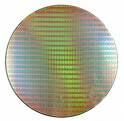A group of industrial partners have said that they have developed a pulling process resulting in silicon crystals with a diameter of 300mm. The process, specifically for applications within the solar cell and module market, can reduce energy consumption in the pulling process compared to smaller sizes and allow the energy recoup time per W (peak) to be faster.
The R&D team included members from key production supply chain companies that included ersol Group, Day4 Energy, Crystal Growing Systems GmbH, SolarZentrum Erfurt and Roth & Rau AG.
Importantly, the larger wafer size adopted by leading-edge semiconductor manufacturers retains the same conversion efficiency of the standard 156mm x 156mm wafer but the new 210mm x 210mm thin silicon (220µm) wafers are claimed to offer 80 percent more power.
"We believe our project will provide a new impulse for the further development of cell standards within the photovoltaic industry," said Dr. Claus Beneking, CEO of ersol Solar Energy AG and board member responsible for technology.
"This project is a demonstration of a strong potential for cost reduction that can be realized through a combination of leading edge technologies at the silicon ingot, wafer, solar cell and PV module levels. These new high power PV cells from ersol clearly show their advantage when combined with Day4's next generation module technology capable of collecting the enormous amount of power these cells generate," adds George L. Rubin, President and Chief Operating Officer of Day4Energy.
A key advantage of using the 300mm ingot pulling process is the greater yield of wafer surface at a comparable pulling rate that maximizes capacity utilization per pulling plant.
However, in terms of factory productivity, 80 percent greater output using comparable production equipment is possible. Processing of the SuperSize solar cells was further enhanced, with ersol able to use one less production step and economize as much as 40 percent of Ag printing pastes while increasing average solar cell efficiency at the same time, the companies claimed.

